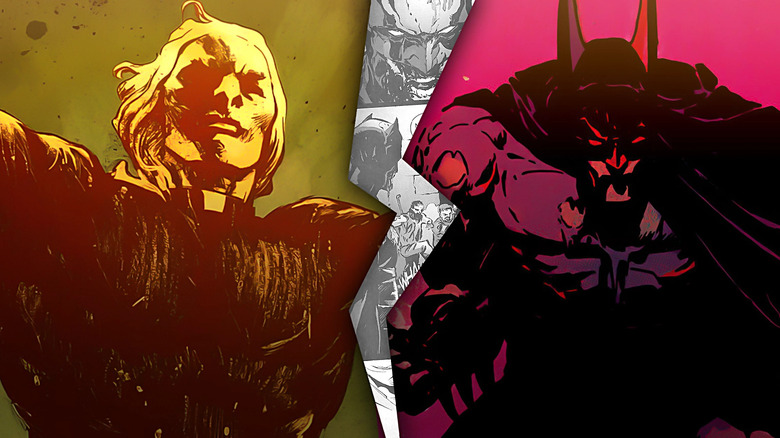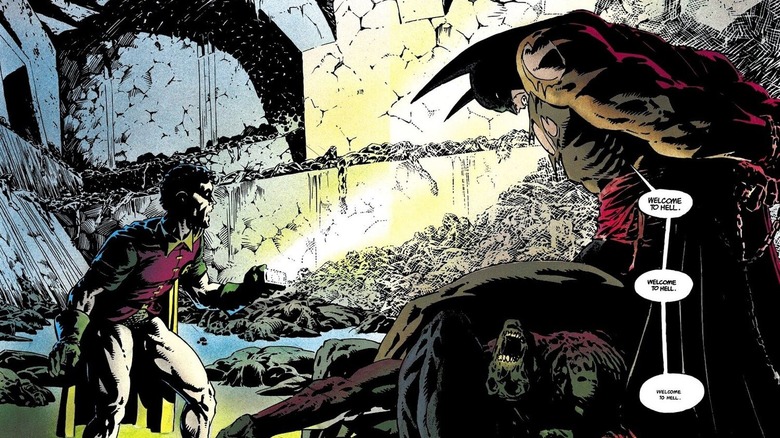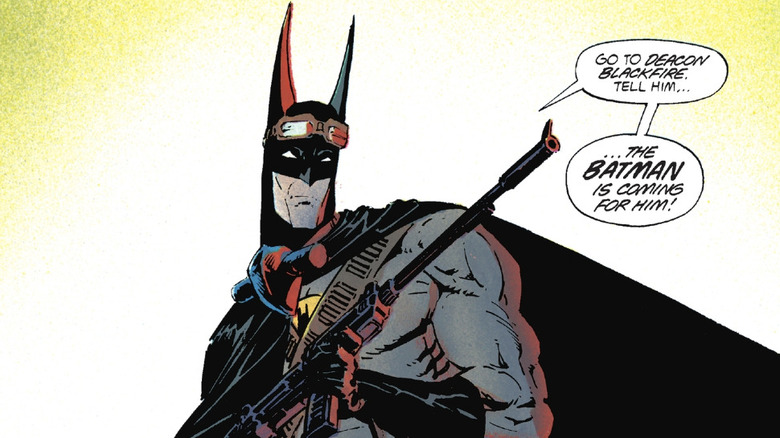The Scariest Batman Villain Has Never Made It Into The Movies
We may receive a commission on purchases made from links.
Many consider Batman the greatest superhero because he has no fantastic powers, even though he's also far from an everyman. It's not just his resources and wealth that make Bruce Wayne an exceptional individual, it's his determination. But just as Batman's all-too human body can be broken, his will is only mostly invincible. Before Bane broke the Bat's back in "Batman: Knightfall," Deacon Joseph Blackfire broke his spirit in "Batman: The Cult."
The Deacon is the villain of that 1988 four-issue comic, written by Jim Starlin and drawn by artist Bernie Wrightson, and leader of the eponymous cult. Religion is not a frequent theme in Batman stories (compared with, say, Daredevil over at Marvel). This makes Blackfire, who dresses and speaks like a priest, stand out all the more compared to Batman's usual eccentric foes.
"The Cult" begins in media res, with Batman chained up inside the Cult's underground lair. Flashbacks reveal Blackfire came into Gotham proclaiming benevolence, and opened a homeless shelter in Crime Alley. But people started disappearing, and when Batman investigated, he fell into the Cult's arms.
The Cult is holding Batman hostage because Blackfire wants the Dark Knight to become part of his family. You expect Batman to do what he always does: slip out of his chains with a hidden lockpick or some Houdini-esque escape trick and save the day. But not this time. Deprived of food and fed hallucinogenic drugs with a sermon from the Deacon, Batman succumbs to indoctrination by the end of issue #1.
Batman's inner monologue shows this is no trick; he truly is defeated and conquered by Blackfire. He doesn't break so much that he commits murder himself, but he stands by while some of the Deacon's other followers do.
Blackfire's origins are kept a mystery through "Batman: The Cult." When breaking Batman down, he claims to be an immortal and chosen by God. A thousand years ago, he was sent as a shaman to Native American tribe, the Miagani ("Bat People"). They rejected and sealed him away, until some unlucky Dutch settler awakened him centuries later. Commissioner Gordon finds proof of Blackfire committing crimes in Gotham as far back as the 1920s, and the Deacon claims that bathing in others' blood sustains his youth. Yet he's also a charlatan, knowingly exploiting religion to mislead the desperate masses and win power, so why wouldn't he lie about his origins?
Blackfire dies at the end of "The Cult," torn apart by his followers after they witness him begging Batman for mercy. He's returned a handful of times, but "The Cult" is the only classic comic to his name. Due to that, it's not surprising that Deacon Blackfire has yet to show up in any Batman movies, as "The Cult" itself is far too brutal for a big budget adaptation.
Batman: The Cult turns a superhero comic into a horror story
In a way, every "Batman" story written after 1986 is inspired by Frank Miller's "The Dark Knight Returns," aka the archetypal "dark and gritty" Batman. But "Batman: The Cult" was written directly in the wake of "Dark Knight," and feels as if it's riffing on it. In some ways, "The Cult" descends even further into darkness. The violence is downright grotesque and without respite; Batman dreams of axe murdering the Joker while chained up by the Cult. Bill Wray's neon coloring, in shades from orange to green to pink, evokes a Giallo film.
One of the signature elements of "The Dark Knight Returns" was scenes of talking heads on television commenting on Batman's actions. Miller's 16-panel page layouts capture the feeling of looking at many screens at once. Starlin scripts several similar scenes in "The Cult" of newscasters reporting on Blackfire's takeover of Gotham, and the split opinions Gothamites have about it.
1988 was also the year that Starlin killed off Jason Todd/Robin II in "A Death in the Family," another story beat lifted from "The Dark Knight Returns." In "The Cult," though, he shows why Robin is so important to Batman. Blackfire's grip on Batman loosens in issue #2, but Robin is the one who actually saves Batman, helping him fight his way out of Hell and retake Gotham.
Batman: The Cult enjoys a sizable DC Comics legacy
Starlin wrote a 1990 foreword to "Batman: The Cult," putting that comic in historical context that includes "The Dark Knight Returns." The censorship of the Comics Code Authority had dissipated while readers were getting older, and comics were rising to meet the demands for darker stories.
"Batman: The Cult" is one such darker story, but Starlin wasn't just out to make the edgiest Batman ever. He made his villain a man of God to comment on how the Moral Majority was growing stronger in influence, and how that same censorship had once (with the Comics Code) watered down Batman:
"Something else once again reared its ugly head during this decade. The self-righteous began to unfurl the crimson banners of censorship. The Attorney General of the United States instituted a pressure campaign to clean up the magazine market. Born-again TV evangelists did entire shows on the evils of comics. Tipper Gore led a movement against the record industry. And now in the '90s, the good Rev. Wyldman and Jesse Helms seek to disembowel the National Endowment for the Arts. It all begins to sound terribly familiar, don't it? I couldn't help but inject some of these tensions into 'The Cult.' Here we have Deacon Blackfire masquerading as a religious leader, hiding behind moral self-righteousness while he furthers his own private agenda. I'll admit his goals and methods are a hell of a lot more extreme than the groups that lobby in our state capital, but they both have one thing in common: they brought Batman to his knees."
Compare this to 1982's "X-Men: God Loves, Man Kills" by Chris Claremont and Brent Anderson. In that story, the villain is an anti-mutant televangelist, Reverend William Stryker. Blackfire certainly talks like a reactionary, and his followers are pointedly shown committing racialized violence, like killing an innocent young Black man walking home.
"Weak liberal laws have crippled law enforcement in this country! The degenerate animals are also aided by inhuman money-hungry lawyers without conscience! Man cannot handle the evil that amasses against him! But God can!" the Deacon proclaims as he brainwashes Batman.
"Batman: The Cult" hasn't been properly adapted yet, not even as an animated film like several other DC Comics have. However, its influence (though not "Dark Knight Returns"-level) is palpable. In 1999, the year-long crossover event "Batman: No Man's Land" featured Gotham City facing a near-apocalypse and being quarantined by the U.S. government, just like what happened in "The Cult." "The Dark Knight Rises" merged the two villains that broke the Bat, depicting Bane (Tom Hardy) hiding in Gotham's sewers with a cult of followers, just like Blackfire.
If "The Batman: Part II" ever makes it past scheduling delays, I can also see Deacon Blackfire fitting into the Gotham City that Matt Reeves built — a grungy, flooded wreck in need of a savior and ready for a demagogue.


